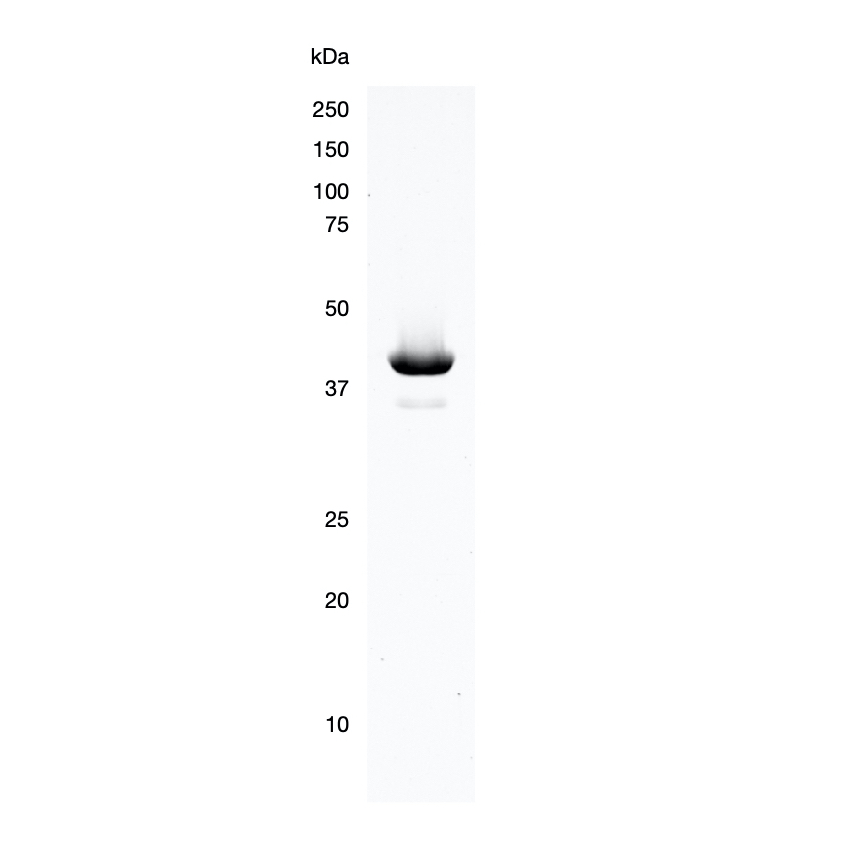
Recombinant Cardiac Actin (ACTC1), labelled with Pyrene, Recombinant Human Protein
€350.00
Labelled with pyrene at cysteine 374
41.79 kDa
Recombinant Human cardiac actin.
Fully functional.
Polymerises and depolymerises.
Activates ATPase activity of myosin.
Purity: >95%.
No Tags.
Sequence:
DDEETTALVCDNGSGLVKAGFAGDDAPRAVFPSIVGRPRHQGVMVGMGQKDSYVGDEAQSKRGILTLKYPIEHGIITNWDDMEKIWHHTFYNELRVAPEEHPTLLTEAPLNPKANREKMTQIMFETFNVPAMYVAIQAVLSLYASGRTTGIVLDSGDGVTHNVPIYEGYALPHAIMRLDLAGRDLTDYLMKILTERGYSFVTTAEREIVRDIKEKLCYVALDFENEMATAASSSSLEKSYELPDGQVITIGNERFRCPETLFQPSFIGMESAGIHETTYNSIMKCDIDIRKDLYANNVLSGGTTMYPGIADRMQKEITALAPSTMKIKIIAPPERKYSVWIGGSILASLSTFQQMWISKQEYDEAGPSIVHRKCF
Postranslational modifications:
Ethylation of N-terminus
Methylation of His73
Cardiac Actin (Alpha-Cardiac Actin, α-cardiac actin) is a specialized actin isoform primarily found in cardiac muscle cells (cardiomyocytes). It is encoded by the ACTC1 gene in humans and plays a crucial role in cardiac muscle contraction, forming the primary component of thin filaments in sarcomeres, where it interacts with myosin to generate force.
Key Functions of Cardiac Actin:
Muscle Contraction: Forms thin filaments that interact with myosin to enable the contraction of cardiac muscle fibers.
Sarcomere Structure: Maintains the structural integrity of cardiac muscle cells, essential for continuous heart function.
Mechanical Stability: Helps withstand the constant mechanical stress experienced by the heart during each beat.
Cell Signaling and Regulation: Participates in mechanotransduction, influencing gene expression in response to mechanical forces.
Structural Features:
Composed of 375 amino acids, with a molecular weight of ~42 kDa.
Found predominantly in cardiac muscle, though it is also expressed at lower levels in skeletal muscle during early development.
Exists in both monomeric (G-actin) and polymeric (F-actin) forms, dynamically assembling into filaments.
Cardiac Actin vs. Other Actin Isoforms:
Isoform | Expression | Primary Function |
|---|---|---|
α-cardiac actin (ACTC1) | Cardiac muscle | Contraction of the heart muscle |
α-skeletal actin (ACTA1) | Skeletal muscle | Voluntary muscle contraction |
β-actin (ACTB) | Non-muscle cells | Cytoskeletal support, motility |
γ-actin (ACTG1, ACTG2) | Non-muscle & smooth muscle | Structural support, stress fibers |
Clinical Relevance:
Cardiomyopathies: Mutations in the ACTC1 gene are linked to familial hypertrophic cardiomyopathy (HCM) and dilated cardiomyopathy (DCM), conditions that affect heart function and structure.
Congenital Heart Defects: Some mutations can lead to structural abnormalities in the heart, impacting its ability to pump blood efficiently.
Muscle Disorders: Defects in α-cardiac actin may contribute to muscle weakness and reduced contractile force.
Importance in Research & Medicine:
Used as a biomarker for cardiac muscle function.
Studied for its role in heart regeneration and potential gene therapy approaches.
Targeted in cardiac drug development, aiming to improve heart function in patients with genetic mutations affecting contractility.
